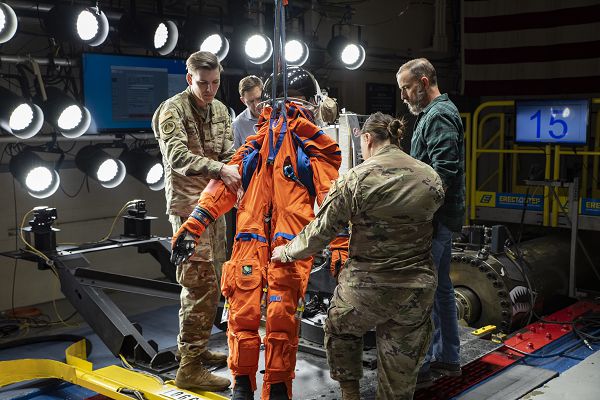
Wright-Patterson Air Force Base, Ohio. (June 4, 2023): In this photo by Richard Eldridge, Air Force Research Laboratory (AFRL) personnel and NASA staff hoist Campos, a fire and rescue training manikin, into a seat at Wright-Patterson Air Force Base, Ohio. AFRL and NASA tested the most current iteration of an astronaut crew seat and flight suit that will be used on the Orion space capsule during the next mission to the moon under the Artemis Program.
The Air Force Research Laboratory (AFRL) is a scientific research organization dedicated to leading the discovery, development, and integration of aerospace warfighting technologies as part of the Air Force science and technology program. The lab was formed in 1997 to conduct numerous experiments and technical demonstrations with NASA, the Department of Energy National Laboratories, Defense Advanced Research Project Agency (DARPA) and other research organizations within the Department of Defense.
The lab’s mission is to develop cost-effective and survivable aerospace vehicles capable of accurate and quick delivery of a variety of future weapons or cargo.
The Artemis mission will land the first woman and first person of color on the Moon using innovative technologies to explore more of the lunar surface than ever before. NASA will collaborate with commercial and international partners and establish the first long-term presence on the Moon. Part of the Trump administration's push towards the moon included an enlarged role for private aerospace firms, including Elon Musk's SpaceX and Jeff Bezos' Blue Origin, to develop landers that can take astronauts to the moon's surface. This will be the first step in America’s quest to send the first astronauts to Mars.
The program got its name from Artemis, the Greek goddess of the moon and twin sister to Apollo, whose namesake program first brought astronauts to the moon in 1969. The Orion spacecraft will be the primary exploration vehicle to sustain NASA astronauts during their journey into deep space and is the culmination of 50 years of spaceflight research and development.
So far, America has sent a series of robots to study the surface of Mars in preparation for an eventual human landing anticipated to occur sometime in the 2030s.


